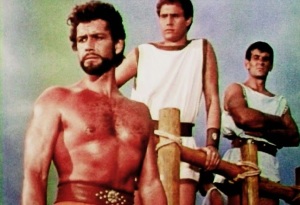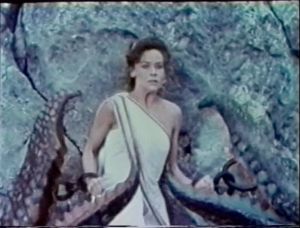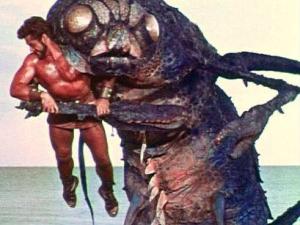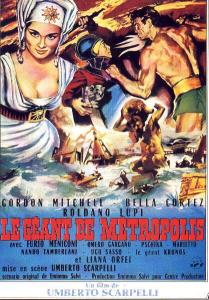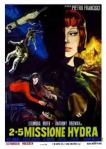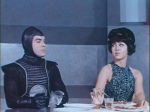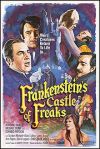‘I’m no longer a Queen; now I am only a woman.’
A sorceress orders her army to attack a peaceful settlement as part of her quest to destroy the last descendants of Ulysses. The King is killed, but his infant son escapes the carnage and comes under the protection of a mighty warrior…
Early Peplum project from director Antonio Leonviola that handed a first starring role to American bodybuilder Gordon Mitchell. Chelo Alonso and Vira Silenti co-star as the women in his life.

During his epic Odyssey, Ulysses tangled with the enchantress Circe, who fell in love with him. After a year together, he abandoned her, and her subsequent curse has lived on ever since. Now, her descendant Queen Capys of Sadok (Alonso), is the instrument of that revenge, targeting what remains of Ulysses’ bloodline for destruction, namely King Agisandro (Germano Longo), his wife Penelope (Silenti) and their infant son (Fabio). On Alonso’s side are the offspring of the Cyclops Polyphemus, who lives in an underground cavern on an offshore island, and her chief general, Iphitos (Dante DiPaolo).
Alonso’s soldiers kill Longo and take Silenti captive in an attack on their settlement. However, a loyal servant escapes, delivering Fabio into the hands of Maciste (Mitchell). Leaving the baby with shepherd Efros (Massimo Righi), Mitchell sets off for Sadok to sort out the problem. Meanwhile, Alonso is visiting the cave of a Sybil, an Oracle who she hopes can locate the missing child. When a sudden storm brings the roof down on her, the passing Mitchell steps in to save her without knowing her true identity.

Despite the interesting premise and presence of the Cyclops, this is very much a pedestrian effort, scuppered to a large extent by the clear lack of a significant budget. This is never more obvious than in the scenes at the Royal Court. The Lost Kingdom Dancing Girls present a number with gauzy veils, which helps pass the running time, but the entire audience is just Alonso, Mitchell, DiPaolo and the court musicians. Production values aren’t threadbare by any means, but it all looks a little second-rate compared to some of its contemporaries. Peplum needs a certain level of spectacle to be successful, and this effort is lacking in that department.
The lack of quality also shows in the action scenes, with some of the combat poorly executed and giving a distinct impression that second takes were only sometimes an option. The mythological elements also turn out to be very slight, with the Cyclops appearing sparingly. The audience gets a brief view of him at the start, and, from then on, he’s AWOL until he’s trotted out for the last few minutes. Although his appearance and the FX that convey his giant size aren’t terrible, they aren’t particularly good either, and his role in the story is little more than as Alonso’s pet monster.

The story follows the usual Peplum template and features all the expected developments. The only wrinkle is that Alonso is a somewhat reluctant villain. Her lineage curses her to carry out Circe’s vengeance, and only when it’s completed can she be free to live her own life. That’s a different motivation from most of Peplim’s evil queens (who are normally bad just because they are!), but, unfortunately, it doesn’t form a major part of the plot. Elsewhere, it’s just business as usual. Mitchell’s trial of strength is in the throne room (I guess the producers couldn’t afford an arena) and involves two tug-of-war teams trying to pull him apart above a pit of lions.
Although her character could be better written, and the English dub doesn’t help anyone, Alonso is suitably regal and arguably performs best. DiPaolo is also good value as the slimy general. Mitchell (billed with his names the wrong way around!) flings a few guards about, flexes his muscles and pulls a few silly faces. However, it was his first leading role, and he did get better with experience. It’s also quite hard to look convincing wrestling a stuffed lion. The costuming is pretty good, but the sets lack the impact of the gargantuan architecture available at the Cinecitta studios; instead, shooting took place down the road at the Istituto Nazionale Luce.

Mitchell was born Charles Allen Pendleton in Denver and served in the US Army during World War Two. He became a high school teacher afterwards before reenlisting to fight in Korea. Later, he obtained work as a bit part actor in Hollywood, appearing in such notable productions as Cecil B DeMille’s ‘The Ten Commandments’ (1956). Sending a photograph to an Italian producer got him signed for this film. It was the beginning of a long career in European genre cinema, initially in many Peplums and historical adventure films but moving to other genres with changes in public taste. There were the inevitable Spaghetti Westerns, Eurospys, and War movies, and he even ventured into science fiction with ‘2+5: Missione Hydra/Star Pilot’ (1966). He continued working throughout the 1970s and 1980s when he was featured in post-apocalyptic efforts such as ‘Endgame’ (1983) and a bizarre retelling of H Rider Haggard’s ‘She’ (1984). He passed in 2003 with over 150 acting credits to his name.

Rather unexpectedly, the biggest star to come out of the film was the 2-year-old Fabio Lanzoni, born in Milan in 1959. As a 19-year-old, he went to America and scored a modelling contract with the prestigious Ford Agency. He was almost immediately hired to participate in the campaign to launch the Gap clothing brand and began photoshoots for the covers of numerous romance novels, giving him celebrity status. He began collaborating with other writers on his own series of romance novels in the 1990s and released an album ‘Fabio After Dark’ in 1993. That same year he was a regular cast member of the syndicated TV drama ‘Acapulco H.E.A.T.’ and went on to cameo in big studio films such as ‘Spy Hard’ (1996), ‘Dude, Where’s My Car?’ (2000) and ‘Zoolander’ (2001). He has been a spokesman for many famous brand products and has his own clothing and skincare ranges. He retired in 2021 and sleeps in a hyperbaric chamber.
Very standard Peplum without a great deal of spectacle. Not the worst, but a long way from the best of its type.



